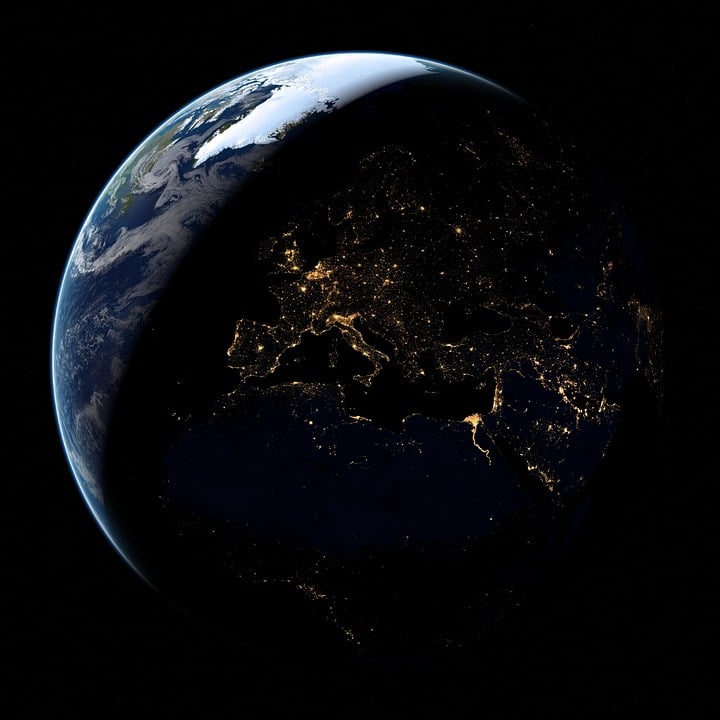Economy
The Earth Is Getting Much Brighter, Which May Not Be Good

Published:
Last Updated:

The earth is losing its night. As new, more efficient, and cheaper artificial lighting becomes more available, people tend to offset the savings by using more light. Half of Europe and a quarter of North America already live with radically altered light-dark cycles.
Artificial lighting has reduced the number of stars visible in some cities to just a few hundred of the masses of stars that populate the night sky. Some researchers suggest that by 2025 an unadulterated view of the night sky will be extinct in the United States.
In a new study published in the journal Science Advances, researchers reported that from 2012 to 2016, the earth’s artificially lit outdoor area increased by 2.2% a year.
The adoption of solid-state lighting technology (LED bulbs) was supposed to result in a decrease in energy consumption. What appears to be happening instead is that the lower cost of lighting has driven an increase in the use of lighting.
Using data gathered from the first calibrated satellite radiometer designed to assess night lighting, the researchers found no reduction in global scale energy. The data indicate that light pollution is increasing “with corresponding negative consequences for flora, fauna, and human well-being.”
Unsurprisingly, most of the growth in light emission occurred in areas that were poorly lit to begin with. Using a threshold of 5 radiance units to measure both total lit area and the radiance of previously lit area, overall radiance rose by 1.8% a year over the study’s period.
In areas where wars are being fought — Syria and Yemen — radiance decreased and in only a few areas — including well-lit countries like the United States, Italy, Netherlands, and Spain — did radiance levels remain mostly unchanged. Lighting growth occurred in South America, Africa, and Asia.
According to the report, for most countries more than half of national light emission above the 5 unit threshold came from areas lit below 20 radiance units. A small town in the American West with a population of several hundred typically generates light emissions only slightly above the 5 unit threshold. An international airport typically emits about 150 radiance units.
Compared to China, the United States has twice as much area illuminated with radiances in the range of 5 to 6.1 units but nearly 20 times as much area illuminated in the range of 132 to 162 units. In many countries, there is little or no area lit above 100 radiance units.
The study’s findings are in line with the historical trend that improvements in lighting efficacy (in this case, the development of LED lighting) results in greater light use rather than in energy savings. The authors note:
Outdoor lighting became commonplace with the introduction of electric light and grew at an estimated rate of 3 to 6% per year during the second half of the 20th century. As a result, the world has experienced widespread “loss of the night,” with half of Europe and a quarter of North America experiencing substantially modified light-dark cycles.
One of the report’s authors, ecologist Franz Hölker told the New York Post:
In addition to threatening 30 percent of vertebrates that are nocturnal and over 60 percent of invertebrates that are nocturnal, artificial light also affects plants and microorganisms. It threatens biodiversity through changed night habits, such as reproduction or migration patterns, of many different species: insects, amphibians, fish, birds, bats and other animals.
Humans spend about 0.7% of global GDP on artificial lighting, and that number is relatively constant regardless of historical or geographical context, and because LED lighting is cheaper to operate, light pollution is likely to increase as cities and towns increase night-time lighting more than ever.
The full research report is available at Science Advances.
Ever wanted an extra set of eyes on an investment you’re considering? Now you can speak with up to 3 financial experts in your area for FREE. By simply
clicking here you can begin to match with financial professionals who can help guide you through the financial decisions you’re making. And the best part? The first conversation with them is free.
Click here to match with up to 3 financial pros who would be excited to help you make financial decisions.
Thank you for reading! Have some feedback for us?
Contact the 24/7 Wall St. editorial team.